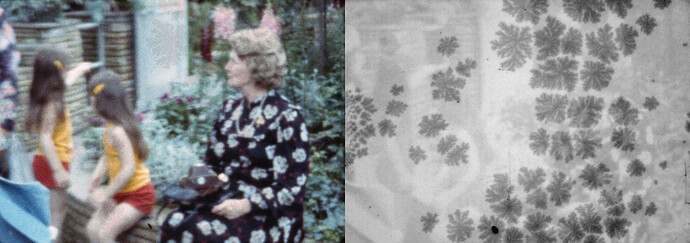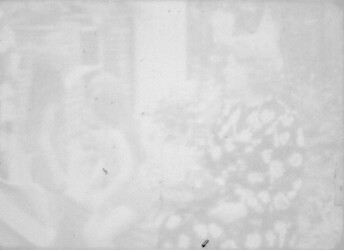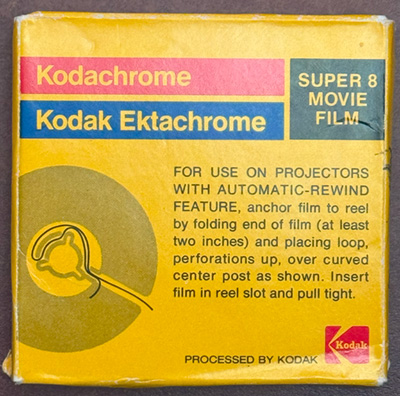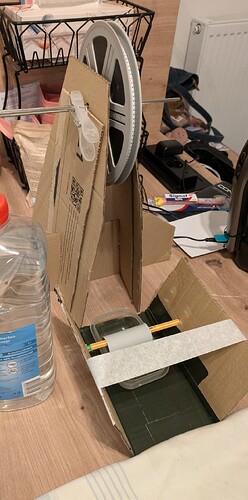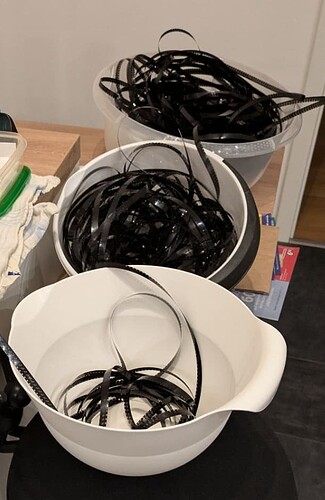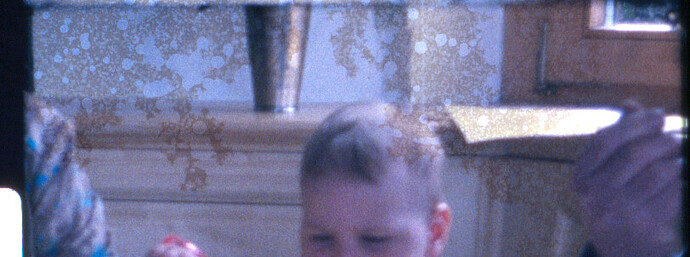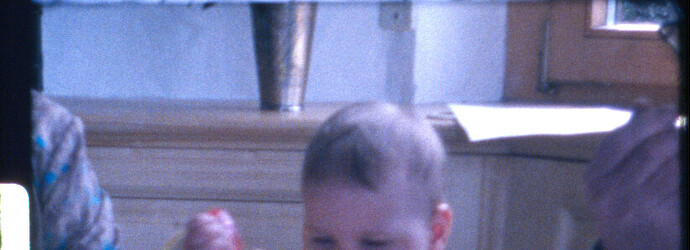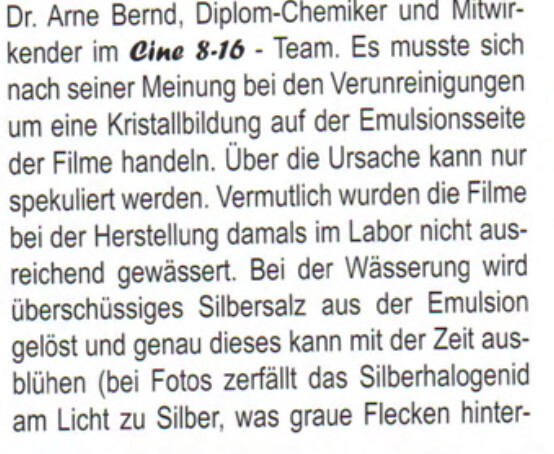For hand cleaning film we use Pec Pads. They’re soft, lint-free wipes that are good for this kind of work. You just need to be constantly using a clean part of the pad so that you’re not smudging what you picked up, back into the film. For detailed work, you can wrap the pad around the end of a cotton swab (the ones with the wood handles are best), and gently clean the film with that, avoiding the mag stripe if you want. It sounds like it might be separating, which means you may not be able to capture that audio. And there’s a very strong likelihood that running it through any machine at this point will cause the mag to completely detach from the film. Just be prepared for that - it happens, and there’s really not much you can do about it.
I recently had a cleaning adventure like the other stories here.
A single reel in my collection had some mold. It was particularly opaque in IR, which was going to ruin my automatic dirt masking:
Armed with PEC Pads and a bunch of solvents I set about trying to fix it.
I started with Isopar G (which appears to share the same 64742-48-9 CAS number with the Shellsol D40 that @dgalland mentioned above). After going back and forth along the whole reel twice with damp PEC pads followed by a dry pass to remove any residue, I checked and… it didn’t seem to have had any effect.
(I didn’t grab a frame at this point–just inspected via loupe–or I would have seen that something had changed.)
Next I switched to 99.9% Isopropyl and wiped down the whole reel the same way again: back and forth twice with damp pads then back and forth again with a dry pad, routinely changing which part of each pad is in contact with the film many times across the reel. For these passes I have the film racked up in an old, manual film “editor” I found on eBay with a handle/crank on both reels.
Spot checking a different frame in my scanner, it still didn’t seem like much was different. (If I’d been more methodical in comparing it with the original scan, I would have noticed that the character of the mold had already changed slightly and that it was already a little darker.)
Discouraged, I poked around and found a bottle of PEC-12 (made by the PEC Pad folks for cleaning both film and optics). Looking up a datasheet, it seems to be a 3:1 combo of ethanol and N-butyl acetate. I wiped the whole reel, checked the same frame and was completely dismayed:
Something was both getting darker and spreading! Only a few minutes had gone by so this couldn’t be some miraculous new mold growth.
I was being careful to not leave any residue or moisture between any of these steps but clearly something was being left behind. Maybe some moisture was being absorbed into the emulsion? As a test, I got a hair dryer and (from a good distance, on low) hit the film with it for a few seconds. No effect besides the spots spreading slightly further, though I expect that amount of creep would have happened in that amount of time even without the dryer.
Now I was out of solvents and starting to panic.
“Don’t use water on your film” is the advice I’ve probably read most across the Internet but I was out of options at this point. And, if it didn’t work, it’s not like the film would be more ruined, right? ![]()
Gently wiping just those few frames with distilled water on a PEC Pad, I took another scan and relief washed over me. It looks like I only hit the lower-left side of the frame, but some of the spots were completely gone now. (Compare the sitting girl’s knees and shirt.)
Finally encouraged that I might not have destroyed the reel after all, I got out the big guns: a small ultrasonic cleaner I had in my basement from an unrelated project.
I tried to unwind the reel (in a semi-controlled fashion) before immersing it in the tray but noticed some “blocking” when it hit the distilled water where the layers of film were suddenly sticking together. This was my first time ever attempting anything like this, so I’m not sure if left over solvent was mixing with the water and causing it or if that’s just something that film does when initially immersed?
Over the next ten minutes, while the cleaner and its heater were running, I (very!) gently worked my way through all 50ft, using the lightest finger pressure to let the film itself work the adjacent layers apart.
Taking some cues from film developing pictures I found on the Internet, I eventually finished drying it on a shower bar, dangling in ~5ft looped lengths. This was after very gently wiping the excess water off.
All of the stress was totally worth it. After drying completely and doing a final dusting pass with a dry PEC pad, the film was completely restored with no sign of mold anywhere:
The IR channel is now completely unblemished and can be used for automatic dirt removal again:
Now that I know, if I had to repeat this exercise, I could probably shave most of the steps off. One solvent and then a distilled water bath is probably enough. But I thought I’d share the story just in case it’s helpful to anyone else running into similar trouble.
Dark, growing blobs can be fixed!
Great sharing this! This seems to be a very similar result to what I described in this post. I cleaned with water, followed by an additional Isopropyl/cloth pass. The main cleaning effect was actually the water pass which got rid of the mold on the film.
Citing myself:
So… - have you any idea of what type of film stock you have been dealing with here? I only have Agfa Moviechrome material which shows this kind of mold.
This was one of those odd boxes that has both names on it:
The IR response does seem to be more like Kodachrome than Ektachrome though, so it’s hard to say why the blue stripe is on there. (Did Kodak just sort of give up and start using the same boxes for mailing both kinds of film back so they wouldn’t need to stock two different types of packaging materials?)
More details: this reel was developed in 1979 and appears to have been stored in exactly the same conditions as the other ~9 reels from the same time period that share the same red+blue stripe on their boxes. But none of the other reels exhibit any problems. This one was an outlier, I guess. ![]()
I have one with this type of mold that says “PERUCHROME S 165” along the perforation. Don’t know how long it was lying around before use, but the footage is from 1983 onwards.
I think the wax(?) layer that was put on these films becomes sticky that way. I had the same thing happen.
Found this article when looking for ideas how to clean the films ![]() (German only, sorry).
(German only, sorry).
Some labs will rewash film in water, but they are few and far between these days. The main issue is that the water can become easily contaminated by whatever the mold was on the film, and getting that out of the tanks is a bit of an undertaking.
And as you discovered, you have to be very careful. As the emulsion absorbs water, pressure on the film can scrape it right off the base. using an ultrasonic bath is smart for something like this because it minimizes contact with the film. Is it one of those small cleaners used in machine shops, and by jewelry makers? I’ve long thought about building a cleaner that used one of those, but I do not need another project right now.
Encountered another stretch of moldy film labeled: MOVIECHROME 40 S 677
It came off (or rather, became invisible) with distilled water.
For cleaning, I roll the film off of a slightly elevated vertical stand and pull it through a little water bath. The film is held down with a sort of roller. Then I dry it vaguely with lint-free swabs and let it fall into a laundry basket to fully air dry.
Sounds elaborate, but the “cleaning station” is made of cardboard, two pens, a plastic tube, clothespins and a small food storage container… ![]()
Yep, it’s exactly that kind. My particular model is no longer available from Amazon, but looking at equivalent 10 liter models with built-in heaters, they’re in the $130 ballpark. Two or three times now it has been an unexpectedly handy thing to have around.
A film cleaning machine that had an ultrasonic bath somewhere along its path would be cool. In that case–depending on how fast the film was moving–you could get away with something a lot smaller than 10L and save some money, too. There are some small 2L models available for around $50.
Haha, that’s great. (And still a lot more sophisticated than my setup!)
… would love to see an image ![]()
It’s not a novel idea. Most film cleaners had an ultrasonic bath and used Perc, or Trichlor, or whatever nasty chemical was being used. Lipsner-Smith sold tons of these machines back in the day and every film lab had at least one of them.
We use a non-immersion Lipsner-Smith, so no ultrasonic. It’s all PTRs and Isopropyl-soaked buffers. Does a nice job, but it’s 16mm/35mm only.
Haha! I was about to post a photo but then noticed the clutter in the background and got a little self-concscious (I had put everything away again in the meantime), but here you go ![]()
And the aftermath:
Clearly underestimated the length of the film and will use said laundry basket in case I find another one to clean like this…
These are the tissues I’m using to wipe the film (also when using isopropanol). No idea what they could be called in English: Pack of 900 Lint-Free Nail Cotton Pads, Lint-Free Nail Wipes for Preparation and Finishing of Nail Art Manicure, Nail Polish Remover Cotton Pads Nail Wipes Pads (White) : Amazon.de: Beauty
I have always said that if you know what you are doing, you can achieve good results with very modest means.
Film cleaning is a task that I still have pending, but seeing your simple device may encourage me to try it.
In passing, I will say that the great majority of my Super8 films are Kodachrome 40. None of these have fungal stains. However, I have noticed colonies of fungi on Agfa material.
On the other hand, the great majority of my slides are Agfa and Perutz, none of them have fungal stains.
Film cleaning is a task that I still have pending, but seeing your simple device may encourage me to try it.
I’ve been really nervous about film cleaning, but the material - at least the Super 8 films I’ve handled so far - seems pretty resilient. You should definitely give it a try. It makes a big difference even if you just wipe the films with a dry cloth and only get loose bits removed. The cleaned films barely need any dust removal in post :).
I remembered this little video I took of just dipping a stretch of moldy film into distilled water. You don’t even need to wipe it off.
I’ve been using these micro-fibre glasses wipes for years. They are machine washable at 30°. Wear-free.
I used some like those for dry cleaning sound film, but was worried they might stick to the wet wax coating. ![]()
These micro-fibre glasses are ideal for cleaning films. But whatever the operation, never dry.
When it comes to using distilled water for films with mould, I find the handling tricky.
Distilled water dissolves the film emulsion if you insist on it too much.
Is there any way of removing this wax without mechanical means (micro-fibre or other)?
For me, the emulsion is always a bit sticky and I don’t feel confident about preserving the film.
And then there’s the problem of the final drying …
To avoid scratches, I guess? I’m switching frequently and not putting on too much pressure, and at least didn’t notice any (new) scratches, but that’s probably meaningless.
I’d get some Film Guard if I didn’t have to import it. I think it’s unreasonably expensive.
Some people in a German forum seem to like this stuff as an alternative to Film Guard, but I’m hesitant ![]() Armor All® Tiefenpfleger Seidenmatt | Armor All - AA DE DE
Armor All® Tiefenpfleger Seidenmatt | Armor All - AA DE DE
Yeah, there are always a few places where the film sticks together, no matter how I put it into the basket. The Super8.tv Link I posted above talks about air drying at 20°C, but I don’t think I can replicate that at home, so I mostly hope I don’t encounter a film that gets damaged during cleaning ![]() .
.
This is a before and after (distilled water, then isopropanol), which I only have because I missed that spot ![]()
The dendriform spots in the image above are undoubtedly colonies of fungi.
They are identical to those I have observed on my Agfa films.
You have managed to remove them completely without damaging the film.
Congratulations on the excellent cleaning job.
I’m still not convinced it’s fungal. This ressource claims it’s some kind of salt.
http://www.olafs-16mm-kino.de/Cine816/Cine%208-16%2025%20%20Kristalle.pdf
![]()
Edit, attempting to be more helpful with the German article, but my knowledge on film development is unfortunately non-existant:
Arne says the “dirt” on the emulsion side of the film is presumably from not watering the film enough during development. Watering would release excess silver salts(?) from the emlusion which could bloom out over time.
Makes sense to me as the “mold” practically dissolves with low pH water.
…Still has to be related to Agfa’s wax layer, though.
Another edit: I’m currently scanning the first film I had cleaned of mold/crystals with the method described in the article (actually swiping the film with a cloth and distilled water), and I think I might’ve “massaged” a few particles into the emulsion that way, which didn’t come off when I cleaned the film with isopropanol yesterday. I didn’t notice that happening with the water-bath method.
I can’t remember the kind of cloth I used the first time, though, so maybe the cloth and not the method itself is/was the culprit. But I’ll definitely stick to the “bath”-way. It’s also much quicker.
